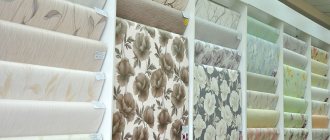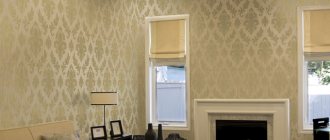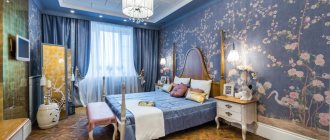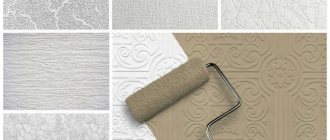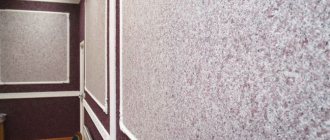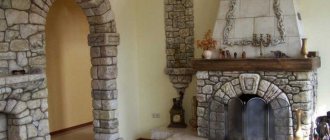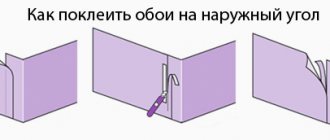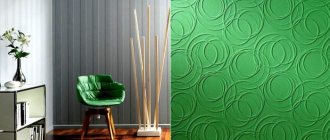MesterulManole
7469 0 0
MesterulManole January 12, 2018Specialization: many years of experience in finishing works of residential and office premises, dachas, country cottages, etc. Hobby: cycling in all its forms
A typical example of a narrow room, the disproportion of which is only enhanced by unprofessional design
From a design point of view, the rectangular shape of the room is inconvenient and that’s a fact. However, nothing prevents you from visually adjusting the features of the room. I'll talk about how to choose wallpaper for a long, narrow room and how to use these materials to visually improve a problem room. As a result, you can take the suggested tips and make your apartment more comfortable.
Types of bricks depending on material
So, before choosing this or that material as a stove lining, you need to understand what its varieties exist depending on certain characteristics.
This will make it clearer which brick products can be used when building a stove. Based on material, bricks are divided into two types:
- ceramic;
- silicate.
The first is made using firing methods based on clay mixtures, and the second consists of a mixture of sand and lime, as well as impurities. This material is made in an autoclave, and if one or another pigment is added to the mixture, it will acquire the desired shade.
When building stoves, it is recommended to use the first type - made of ceramics. This will be discussed further. Depending on the application, they are also divided into the following:
- ordinary solid brick - it is used for internal masonry;
- facing or finishing - such bricks are needed for finishing the finished masonry of an already completed building. Unlike the first one, it has a more uniform structure, looks more neat and has smooth edges.
Ideas for a wooden house
Small country houses and cottages often have low ceilings - this is a necessity, since fewer resources are spent on heating. Therefore, the task of visually increasing space is especially relevant here.
Most of the techniques described above are suitable for wooden houses, but a number of other nuances are also taken into account:
- For finishing, use light-colored wood - this will expand the space. Dark shades steal a few centimeters and make the room cramped and uncomfortable.
- Accessories must match the color of the walls. Wooden furniture of the same shade is most appropriate.
- The walls, in turn, are covered with a slightly darker varnish or wax than the ceiling, so that against their background it appears lighter.
- Coffered ceilings are often installed in a wooden house. This is a volumetric finish made of perpendicularly located beams that form cells. The beams are painted a darker color or made lighter in comparison with the base. Due to the contrast, it is possible to visually increase the height of the ceiling.
There are also more radical methods that require certain skills in the construction and repair of such buildings. For example, you can lower the floor. They do this as follows:
- Remove the floor covering.
- Remove old logs. The part may extend into the area of another room, so maximum care is needed.
- The holes formed in the walls are sealed with mortar.
- Cut holes for new logs so that they are lower than the previous ones by a maximum of 25 cm. Install the parts.
- If necessary, insulate the floor. Then the rough coating is laid, then the finishing coating.
Another way is to change the headliner. This option is suitable if the load-bearing beam system is hidden under the finishing material. In this case, the old coating is dismantled and a new one is installed just above the beams. The process consists of the following steps:
- Remove the old finish and dismantle the sheathing.
- Damaged ceiling beams are restored or replaced. The structure is treated with impregnations against fungi, rot and pests. Surfaces are opened with varnish, wax or paint.
- The space between the beams is finished with wooden lining or other decorative materials. First, a layer of thermal insulation is attached to the roof truss structure, on top of which a new ceiling is hemmed.
Color influence
According to professional designers, the right shade can give a room spaciousness. For this technique to be successful, you must combine the color of the walls with the overall color of the room - you cannot combine too different, flashy shades. Both the walls, the ceiling, and the floor should be selected in the same color scheme. This also applies to interior items, including curtains and furniture.
The walls, ceiling and floor are chosen in the same color scheme
Well-known fact: Different colors not only have an impact on a person, but also have their own special purpose. Shades such as peach, yellow or beige will help add coziness and warmth to the room. Most often, such wallpaper is used in living rooms, since this is where most of the time is spent. A sunny environment will help drive away fatigue and depression.
When choosing your color, you should remember that dark variations will not help solve the issue of visual expansion, but quite the opposite - saturation will take away some of the light, and therefore space.
For a bedroom or children's room, it is better to choose relaxing, soothing motifs. Light pink, blue, and light green colors cope well with this task. Don’t forget about white, an ideal and pleasing color to the eye.
Girl's room in light pink colors
There is a concept of dividing colors into two groups: warm and cold. Warm ones will stimulate a good mood and increased energy. These include red, orange, yellow - it is strictly forbidden to use them in a narrow room. But cold, soothing, harmony-giving blues, whites, greens and light greens will help expand the room. You should not use too bright, saturated colors.
It should be noted that the use of light colors will help in a room with an area of more than eight square meters. If the room is smaller, then if you use too light, cold tones, it will begin to resemble a hospital ward or public toilet. In this case, it is better to use other optical techniques: installing a fresco or photo wallpaper, laying mosaics in light, cool tones. For example, a blue color will help create the effect of moving objects away, which means it will visually expand the space
But warm orange, on the contrary, focuses attention on objects, which means it will make the room look narrower.
Living room interior 7 sq.m.
For cold, north-facing rooms, you can use patterns of warm colors and the same texture - this will help make the pattern voluminous and soft. Gold, yellow or orange colors will help create an atmosphere of warmth and comfort. Also, peach and beige will be a great addition to the overall look.
Warm colors will create a warm atmosphere
Don't want to use color schemes? Play with contrast - install a fresco on one wall, made in the same colors as all the walls. But the image should be one tone higher, that is, lighter.
Colors
When designing a corridor, the main attention should be paid to the illumination of this room. If for a well-lit hallway there are no particular difficulties in choosing a wall covering, then for a dark corridor you need to choose wallpaper in light and rich colors that expand the space.
Bright colors should not be used due to the fact that they tend to absorb light.
Most preferred colors and designs
Many people have literally absorbed a simple truth with their mother’s milk: dark colors narrow and make you look slimmer, while light colors expand and make you look fuller. The rule has remained unchanged to this day.
To visually change the size of a small room to a larger size, here are the ones to choose:
- lactic;
- beige;
- apricot;
- cream;
- caramel;
- golden;
- green;
- blue;
- pink;
- grey;
- silver color.
All colors chosen for a modest-sized room should be warm. Cool shades will further narrow already small rooms (how to choose the right wallpaper color?).
In addition, you should not be afraid to use wallpaper with patterns (read about how to adjust wallpaper to a pattern here, and from this article you will learn how to properly and economically glue wallpaper with a pattern). After all, without them, firstly, it is impossible to create such design styles as Provence, modern or classic. And, secondly, correctly, well-chosen prints help to achieve the desired effect faster.
The following have “expanding” properties:
- medium-sized stripes;
- large, single arranged flowers;
- small patterns on a contrasting background;
- geometric shapes located separately from each other.
Combining photo wallpaper with plain canvases or intersecting a bright bottom with a muted top on one wall will help expand the space of a child’s bedroom (find out how to choose the right photo wallpaper, glue it, and also make a picture out of it).
Acceptable decorative elements
To visually expand a narrow corridor or hallway, you need to know the following subtleties:
- use of special lighting. Built-in lamps in furniture and walls will help make the corridor larger;
- application in decorating paintings;
- To cover the floor, use carpet runners or small rugs with an original design, as in the photo:
How to choose a bedroom: fashionable options, stylish solutions and practical tips. Arranging the bedroom interior: design and layout options
Some tricks for demarcating a small space
You should not ignore the redevelopment of a small apartment into a studio; this option will significantly add space to the room, despite the fact that it will have to be divided into zones.
Mirror. The long-known method of increasing space with the help of mirrors is used by many modern designers. To give the room a regular, square shape, you should mount a reflective surface on one of the long walls. A mirror originating from the floor or a reflective ceiling is a good way to adjust the volume of meters.
Furniture in small rooms should be only the most necessary, so as not to overload the space; it is best if it is multifunctional. If you plan to place objects along the wall, then the same color as the vertical surface will help smooth out the narrow room. Placing low furniture will create the illusion of high ceilings.
Decor
The use of a bright, single decorative element, a vase, a figurine or something else on a light background will draw attention to the object, thereby distracting it from the space.
Doors. By choosing ceiling doors for your home, you can significantly extend it.
Carpets
A large carpet on the floor, unfortunately, will not add visual meters, but rectangular and medium-sized specimens will be appropriate. Animal skins with uneven edges will help give the room the correct shape.
It is not recommended to place large indoor plants in small-sized housing, and also to clutter it with a large number of trinkets.
By following the rules described above and using some tricks, you can not only adjust any shape of the room, but also make even the smallest room comfortable for living.
Narrow nursery design
If you have two children, then a symmetrical arrangement of furniture along opposite walls can save a narrow room.
In addition, each child will have good lighting and ventilation. mychildroom.ru
If the children's room is very narrow, a bunk bed will come to the rescue.
mychildroom.ru
A loft bed for one child is also a good functional solution.
mychildroom.ru
Or, as in an adult bedroom, you can create storage space under the bed and put toys there.
mychildroom.ru
The role of proper lighting and floor finishing
The visual perception of a room depends on the size of the windows. The more natural light there is, the more spacious the room appears. Small windows should not be covered with dark textiles; blinds, Roman or light air curtains would be appropriate. If it is possible to make windows without partitions, then you should take advantage of it. Solid glass completely changes the perception of a room.
How to visually enlarge a room when finishing a floor? It is necessary to use a uniform coating or with longitudinal stripes across the width of the room. Various diamonds, squares and other decorations on the floor visually reduce the space. A multi-colored carpet is also not welcome, as the texture of the floor will create a squeezing effect.
Any other coatings should be chosen without obvious patterns; it is recommended to pay special attention to shiny elements. It’s good if the doors and frames don’t stand out too much, but match the shade of the walls
General information
A living room or bedroom may have this disadvantage, however, in this case the term “narrow room” is relative. It would be more correct to say - a room with an unfavorable ratio of length and width.
The most “narrowed” ones, most often, are the corridors. But even they can be made more attractive. Of course, the traditional solution in the form of plain wallpaper is not suitable in this case, since the “carriage” effect will be felt.
Therefore, such premises require a special approach. In particular, the use of various color effects and the correct selection of patterns will help to “push apart” the walls.
In the photo - photo wallpaper in the interior of a narrow room
What furniture to use to visually enlarge the room
Logic dictates the use of multifunctional furniture in small spaces - furniture that takes up minimal space when folded. Such furniture includes a sofa bed, a chair bed, all kinds of built-in beds, tables, and wardrobes. All of them save valuable square meters, while delivering a minimum of discomfort to household members.
If we talk about dimensions, then there is no need to choose bulky sofas, cabinets and tables. It is better to give preference to neat models made from light and weightless materials, such as rattan and glass. But even a classic sofa will fit well into a small room if you choose the right size. Use your imagination and calculate different options, the main thing is to respect the proportions of the room and furniture.
Upholstered furniture should not be too “lush” or voluminous. It is better to adhere to its strict forms.
What furniture visually expands the space
What furniture to choose for a small living room
Furniture for a small apartment
Furniture for a small bedroom
How to visually enlarge a room photo
No. 6. Features of different rooms
The rules described above are equally valid for all long and narrow spaces, but still, when arranging different rooms (living room, bedroom, etc.) it is worth taking into account some nuances.
Narrow and long living room
The largest room in the apartment is usually allocated for the living room, because this is the gathering place for all household members and guests. If you only have a long narrow room at your disposal, then it will not be easy. It will be doubly difficult if the room is small in size.
If the living room has a decent length, then it is best to arrange several zones . One will have a sofa with a TV and other attributes of a living room, the other will have a dining table, a work table, or a play area for children.
If the living room has the shape of a pencil case, and is also small, then you may have to abandon the traditional large sofa. It can be replaced with a couple of compact sofas or several armchairs. They must be placed in different planes: parallel and perpendicular to the long wall. Light coffee tables and multifunctional furniture will come to the rescue. Storage spaces are organized on open shelves and in a small console, which can double as a TV stand.
Narrow long bedroom
You can’t do without a bed in a bedroom, so its location is thought out first. It all depends on the size of the room and the bed itself. The standard length is 1.9-2 m. The width of a single bed is about 90 cm, a single bed is up to 140 cm, a double bed is 160-170 cm. Do not forget that you still need to leave room for movement around the bed - at least 50 cm on each side sides, preferably 70 cm.
As a rule, there are no problems with a single bed. If you want to install a larger bed, you will have to carefully calculate everything. It is best to place its head against a long wall, but another option is also possible. As a last resort, you can move the bed one side to the wall.
If the bedroom is very elongated in length, then you can give part of it to create a dressing room. The remaining space on the opposite side can be used to install a work or dressing table.
Narrow and long kitchen
Setting up a long kitchen is the most difficult. As a rule, a linear layout is used and all kitchen furniture and appliances are installed along one wall. It would be great if you can use a short wall with a window and install an L-shaped kitchen. In this case, the geometry of space will be partially saved.
Only part of a long wall can be used for a kitchen set. The remaining space along the short wall can serve as a dining area. This is a pretty good solution. You can also recommend using translucent chairs.
If the kitchen is small, then it makes sense to move the dining area into the next room, but if this cannot be done, then compact bar counters and folding tables will come to the rescue.
Finally, we note that it is worth thinking through the design of a pencil room in advance, and during renovations, act with extreme caution so as not to steal useful space, so it is better to avoid drywall as a means of leveling walls if possible.
The article was written for the site.
Tags:Apartment design
Choosing wallpaper for a small room: wallpaper with a pattern
Of course, light and plain wallpaper will greatly visually expand the space of the room, but at the same time give it a very boring and conservative look.
The use of patterns and ornaments on wallpaper will add a more colorful and positive mood to the interior, but not all of them are suitable for small rooms.
For a small room, photo wallpaper is not the best option: in extreme cases, it is permissible to hang photo wallpaper with a small pattern
How to choose patterned wallpaper for small rooms:
- Firstly, wallpaper with a small, non-contrasting pattern can completely replace plain wallpaper, while a large pattern, even with a slight contrast, can significantly spoil the decision to visually increase the volume of the room. The correct option for using wallpaper with a large pattern in a non-contrasting color would be to paste it on one wall of the room, against which low furniture such as a sofa or bed is placed. For example, using wallpaper with a floral print will look spectacular in the bedroom at the head of the bed.
- Secondly, for small rooms, wallpaper with a rare contrasting pattern of small or medium size is suitable, which will enliven the interior of the room and will not reduce the space. For example, in children's bedrooms, wallpaper with small images of cars for boys, or characters from the animated series “My Little Pony” for girls will look effective. But you should completely abandon the use of large contrasting patterns on wallpaper, as they can eat up a large volume of the room.
- Thirdly, you should not consider decorating small rooms with wallpaper with high contrast and pattern density. Even a room with a small amount of furniture will visually seem too cluttered and uncomfortable. Therefore, you should either completely abandon this type of wallpaper. or allocate only one wall of the room for them.
Concluding our discussion about the use of wallpaper from drawings to decorate small rooms, it is worth mentioning once again that it is worth focusing on light shades of color, which visually increase the space of small rooms.
Wallpaper type
For small hallways, practical and durable wallpaper is traditionally chosen, which will allow you to keep the walls spotlessly clean without any effort or expense. The environmental safety of the material is of no small importance. In typical apartments there are no windows at the entrance to the living space, so wall coverings must have good breathability and not emit toxic substances.
When purchasing wallpaper for a small hallway, in addition to aesthetic parameters, special attention is paid to the practicality of the material. It should be wallpaper from which dirt can be easily removed. The following types of canvas meet the listed requirements.
- Paper or non-woven with a vinyl top layer - such wallpapers are considered the most budget-friendly, and in stores they are presented in a wide range of colors. Practice shows that the canvases are environmentally friendly and durable; they can be applied to drywall, plywood, plaster, concrete and any other coatings. However, over time they tend to fade, so if your hallway has a window, then after some time the paint on the walls will fade.
- Paper - in this case we mean options intended for wet cleaning. There are 3 types of such wallpaper: those that can be wiped with a suede cloth, those intended for cleaning with a sponge, and those that allow the use of cleaning agents. Washable wallpaper in light colors can be a good choice for a cramped corridor; an important advantage of this option is the affordability of the canvases.
- Liquid - these wallpapers are very popular due to their ease of application combined with a high level of sound insulation. The smallest hallway with such wallpaper becomes warmer and more comfortable, while the damaged part is easy to replace - you just need to apply a new layer of material.
- Wallpaper made from fiberglass is one of the new products in the construction industry. Such coatings can be easily removed using a solvent, and if necessary, change the boring color to a new one. Glass wallpaper is characterized by hygroscopicity and resistance to mechanical damage, it is easy to clean with a brush and soap solution, and does not emit hazardous substances. At the same time, the canvases have a very high cost, and in addition, it is impossible to cope with their gluing on your own.
Built-in Entrance Hall: Versatile joinery for luxurious style. Built-in hallway: pros and cons, varieties, choice, examples in the interior
- Fabric - these wallpapers include 2 layers: paper on the bottom and woven on top. The coatings look expensive and very impressive, but at the same time they absorb dust and dirt well, so careless treatment is unacceptable for them, and the cost of such options is very high.
The optimal option, from a price/quality point of view, would be non-woven wallpaper ; they can withstand temperature changes, do not allow moisture to pass through, do not wash off or fade. And if you are tired of their color, you can always refresh it by applying paint of a new shade. Such models not only visually expand the space of a small hallway, but also save money for the owners of the premises due to the durability and exceptional practicality of the coating.
How to visually enlarge a room with wallpaper
Choosing a suitable finishing material for the walls will help not only to zone the room if necessary, but also to blur its boundaries.
A wallpaper pattern with vertical stripes is suitable for low ceiling rooms.
Horizontal lines, on the contrary, will elongate the room in length.
Large decor, in the form of a panel or painting, placed on the far wall of a narrow room will attract attention. It is better to make the remaining walls in a neutral color, this way you can partially erase the boundaries of a narrow room.
How to visually expand a narrow room
- The pop art style applied to a small room will add additional meters to it due to optical illusions created by bright figures.
- Photo wallpaper on one wall in combination with a small pattern on the second will give the room uniqueness and delimit it a little.
How to use photo wallpaper to visually enlarge a room
- A 10–20 cm indentation of the wallpaper from the ceiling, if the height of the room allows, can adjust the size of the space.
- Photo wallpaper for the ceiling with a picture of the sky can make the room limitless.
- Combining wallpaper will be a good solution for a non-sunny and low room. To do this, use light wallpaper on top of the wall and dark wallpaper below.
- Wallpapering the ceiling by 15–25 cm will help increase the height of the apartment.
Selection rules
When choosing wallpaper for a small corridor, you need to consider the following:
- It is necessary to limit the use of dark colors or play with contrast, for example, with white doors or white furniture.
- Bright shades, for example, red or orange, will create a festive atmosphere in your hallway, but here you need to use moderation. Bright colors must be diluted with calm pastel tones.
- You need to choose the right drawing. If you choose striped wallpaper, then you need to take into account that vertical stripes narrow the room, and horizontal stripes, on the contrary, expand it.
- An interesting solution would be to combine wallpaper of different colors. In this case, aesthetic and practical problems can be solved.
- When choosing a finishing material for the walls, think about whether it will match the floor, furniture, and whether it will suit the style.
Basic rules for using photo wallpaper
There are a limitless number of photo wallpapers on the market, but not all of them are able to expand the space. Moreover, even those that work well to increase space in one room will be completely useless in another room. Each room requires an individual approach, and the smaller it is, the more carefully you need to approach the choice. For example, a photo wallpaper with a large flower on the wall of a tiny room will play a cruel joke - the room will only seem smaller.
So what kind of wallpaper can really expand the space in a small room? Designers advise considering the following rules when choosing:
- The main task of all techniques aimed at expanding space is to erase boundaries or move them, as it were, outside the premises. For these purposes, panels with perspective work best, incl. those with a horizon line;
- Light shades expand the space well, while dark shades do the opposite. This is a fundamental rule that almost everyone knows and uses;
- if it is necessary to extend the room in height, then use photo wallpaper with vertical stripes, but you should not take this information literally, because vertical stripes can be tree trunks or skyscrapers in the image of megacities. To visually expand the room in width, use wallpaper with horizontal stripes, which work well with horizon lines in landscape images;
- The texture of photo wallpaper is also important, since smooth glossy canvases, due to their reflective properties, although slightly, expand the space of the room;
- Separately, it is worth noting 3D photo wallpapers, which, due to a special printing technology and the correct choice of colors, appear three-dimensional. They expand the space well, which will be discussed below, but in especially small rooms you need to be extremely careful, since the 3D effect can only be appreciated from a certain distance, and if there is not enough of it in the room, then the effect will be exactly the opposite - the image will be crushed and even irritate, and it will be difficult to find in such a room for a long time;
- In the desire to maximize the space, one must not overdo it. For example, a combination of photo wallpaper with perspective, multiple mirror and reflective surfaces, a mass of lamps is a direct path to creating a room where it will be impossible to spend time;
- Photo wallpaper that expands the space is a fairly active element of the interior, so the remaining finishing elements should be calmer. This primarily concerns the flooring and the design of the remaining walls.
The best wallpaper for the hallway
Since the hallway is the most polluted place in the apartment, because all the dirt that was brought from the street remains in it, it is better to choose wallpaper for a narrow hallway:
- durable;
- practical;
- with the possibility of wet cleaning.
Wallpaper for a narrow hallway in an apartment that will fit the following requirements:
- non-woven or paper with a vinyl outer layer. They are considered one of the inexpensive wallpapers and have a wide range of colors. In practice they are durable. They are considered one of the environmentally friendly species. Can be applied to any coating, for example, old wallpaper, plywood, drywall. But they tend to fade;
- paper wallpaper with a water-repellent layer. Three types can be distinguished:
- those that can be wiped with a suede cloth;
- damp sponge;
- or wipe with a damp sponge using chemicals.
These would be a good choice for a narrow hallway, so you can safely use washable wallpaper in light colors;
- liquid. Popular for narrow corridors due to their ease of application and high level of soundproofing. The hallway with such wallpaper becomes warmer; it is easy to replace the damaged part by covering it with a new layer. When applied with a special varnish, they will serve for a long time;
- glass fiber wallpaper. These are a novelty as a covering for a narrow hallway. The main advantage is that it is easy to replace a boring color with a new one, and remove it using a solvent. They have good resistance to damage and moisture. It is easy to clean the surface with dirt using a brush. They are environmentally friendly, but have a high price and are difficult to stick alone;
- fabric. Two-layer - the inner layer is paper, and the top is fabric. They have high thermal insulation, which will be suitable specifically for the entrance area. They look luxurious, but tend to absorb dust, are unacceptable for careless treatment and have a high cost. Look at the presented photo:
- natural. Made from bamboo, reed or cork. They are environmentally friendly and therefore cannot cause allergies. They are waterproof and resistant to friction, which is typical for a narrow hallway. But they have their disadvantages in the form of a high price, a small selection of colors and the need to contact a specialist for installation;
- non-woven. Another new product with a creative design. They have beautiful unusual patterns, but have a small selection of colors. They tolerate temperature changes in the house well, do not allow moisture to pass through, do not cause allergies, and are durable. If the old one is already boring, then you can repaint it. But they have their disadvantages, such as transparency and high cost.
Advice! If you choose vinyl wallpaper, you need to know that when glue is applied, they swell, but when dry they take on their previous appearance.
Color spectrum
Colors evoke different sensations, and each of them has its own purpose. You can visually enlarge a room with wallpaper. The main thing is to choose them wisely. Warm shades - yellow, beige, peach - give a unique coziness. This wallpaper is perfect for the living room. Bright rich colors drive away depression, fatigue, and charge you with energy. It should be remembered that if the question is how to visually enlarge a room, then it is necessary to avoid too saturated and dark colors - they “take away” space and light. Delicate pastel colors of pink, pale green, light blue are calming and relaxing, so they will be an excellent option for a bedroom or nursery.
Volume and proportions are at the mercy of color and graphics
How can you influence the perception of the interior using special wall decoration techniques, and what wallpaper for a narrow room is of interest?
The following methods of decorating walls harmonize the space and make the interior memorable:
- Sticker of white frieze under the ceiling.
- White ceiling, light floor and light wallpaper on long walls. For short walls, choose wallpaper in dark or rich, bright colors.
- Covering long walls with panels with vertical or square panels.
- Dividing a room into zones and covering them with different wallpapers from the same collection.
- Accent panels the full height of a long wall.
Accent wall in a narrow living room
- Playing with graphic designs - stripes, diagonals, diamonds, lattices, dark or contrasting patterns.
- Using photo wallpaper in a narrow room - the photo shows examples of pasting for a short and long wall.
Light wallpaper in a narrow room visually expands the space
Panel: dividing the wall into three parts
You have already seen that it is not necessary to cover the longest wall with one type of wallpaper. Let's give another interesting example.
If the sofa in the living room is placed along an extended wall, then an accent panel is directly “asking” above it - from floor to ceiling or a slightly smaller size. Borders can be emphasized with molding. In order for the panel to attract attention, it requires special decorativeness. Again, collection manufacturers will come to the rescue - in their catalogs you can choose both basic and accent wallpaper for a narrow room (photo below).
Contrasting wallpaper divides the wall into 3 parts
Optical effect
Light objects appear larger, which is why designers use this technique when decorating interiors. Light decoration visually expands the space - just use a cool pastel color or white color on the walls.
You should also choose furniture in light colors, while the walls, ceiling and floor should be slightly different in tone.
Wall decoration
Wallpaper is often used to decorate walls. This material provides a wide range of options for visually adjusting the room. Vertical stripes or patterns make the room visually taller, while horizontal stripes, on the contrary, help expand a small room.
You can correct the proportions of an elongated and narrow room by brightly decorating one of the walls. With the help of a small print or discreet ornament, the room will gain volume.
You should be careful when choosing a geometric pattern on your wallpaper. Depending on its color, scale or location on the canvas, the room as a whole is perceived differently.
Using a large drawing on one wall, make its plane closer
This technique is recommended for elongated narrow rooms, where it is important to reduce the length and visually increase the width of a small room
Photo wallpapers give an excellent effect. Therefore, when choosing them, you should take into account their ability to radically change the perception of the room. Thus, an image on a photo wallpaper stretching into the distance enlarges the room, while the lack of perspective, on the contrary, reduces it.
Ceiling decoration
Not only walls, but also the ceiling can help to enlarge a small room, creating the necessary space using stretched glossy fabric - this is the easiest way.
However, it is worth remembering that an almost mirror surface doubles the objects in the room, so this option is best suited for modern interiors in the spirit of minimalism.
To maintain the illusion of spaciousness, but not to overload the space, combined stretch ceilings with glossy and matte textures are used.
You can adjust the geometry of an elongated room with transverse polyurethane ceiling beams that contrast with the shade of the ceiling.
Stretch canvases with photo printing in the shape of the sky add volume to the room.
How to fix the low ceiling effect
To make a room appear taller, several methods are used. First: vertical stripes, drawings, patterns on wallpaper, made with paint or using hand-painting techniques.
High door and window openings, as well as straight cut plain curtains, help to visually make the walls taller.
Narrow vertical mirror inserts on the walls will not only increase their height, but also expand the space.
Floor decoration
For small rooms, it is recommended to choose plain light shades of flooring materials. To make the room look more spacious, you can focus on the layout of the laminate - diagonally or herringbone.
The illusion of no wall
Landscape photo wallpapers in a narrow room can create a real sensation if they show perspective. Edges can be lost in haze or out of focus, this will enhance the presence effect. The wall doesn't just recede - it gets lost in this haze. In any case, the gaze definitely does not rest on it, it slides further into an indefinite distance.
Interestingly, photo wallpaper on a short wall is also useful for a long narrow room, but their choice and method of pasting is dictated by other considerations.
- The overall tone should be darker than the main color of the walls, or brighter.
- Macro photography is encouraged. An enlarged image is impressive and attracts the eye, but the main secret lies elsewhere - large objects “come closer” to the viewer, which is what is required in this case.
- The entire space “from wall to wall” is covered with photo wallpaper.
- A strong technique is when photo wallpaper covers adjacent walls by 30-70 centimeters. The technique works well when the canvases depict some romantic cityscape with a strong perspective.
Photo wallpaper creates perspective in the room
An even stronger effect, up to the curvature of the walls, is created by photo wallpapers with geometric motifs that cause visual illusions. Are you ready for some intense sensations? Then try to repeat these projects.
Spectacular with photo wallpapers with geometric motifs
What furniture to use to visually enlarge the room
Logic dictates the use of multifunctional furniture in small spaces - furniture that takes up minimal space when folded. Such furniture includes a sofa bed, a chair bed, all kinds of built-in beds, tables, and wardrobes. All of them save valuable square meters, while delivering a minimum of discomfort to household members.
If we talk about dimensions, then there is no need to choose bulky sofas, cabinets and tables. It is better to give preference to neat models made from light and weightless materials, such as rattan and glass. But even a classic sofa will fit well into a small room if you choose the right size. Use your imagination and calculate different options, the main thing is to respect the proportions of the room and furniture.
Upholstered furniture should not be too “lush” or voluminous. It is better to adhere to its strict forms.
What furniture visually expands the space
What furniture to choose for a small living room
Furniture for a small apartment
Furniture for a small bedroom
How to visually enlarge a room photo
Raising the ceiling
Taller and longer
It seems that in a room with high ceilings you can even breathe easier, and achieving this effect is not so difficult. The most obvious trick is to stick wallpaper with a vertical pattern on the walls. It is better for the pattern to be discreet, but only a small area can be highlighted with bright stripes or an active pattern. Narrow cabinets and shelves, long vases, wall mirrors and paintings in high frames also visually raise the ceiling. And it’s better to hang them a little higher than usual.
It seems that in a room with high ceilings you can even breathe easier, and achieving this effect is not so difficult.
Game of color and light
To create the effect of a high ceiling, its lighting is of great importance. You need to choose a small chandelier or lamp with beams of light directed vertically upward. But you shouldn’t use wide curtain rods - they visually make the ceiling line lower. It makes more sense to make a hidden cornice and hang plain curtains that reach the length of the floor.
Cold and light shades visually increase the height of the ceiling. You can also paint the ceiling and walls the same color, but make the ceiling a little lighter in tone. Gloss paint creates a more pronounced height effect than matte paint.
Size matters
If the furniture in the room is quite low, then the ceiling seems visually higher
Bright carpets on the floor have the same effect: they attract attention and create the illusion of high ceilings in the room
Types of wallpaper for the corridor and hallway of a city apartment
The correct choice of finishing is always made taking into account the disadvantages and advantages of a selected area or the entire room. Wallpaper for the hallway in a small apartment is carefully selected according to tone, because in such a room there are practically no windows, which excludes the possibility of natural light. There are other requirements:
- wall decoration should correspond to the general style of the room;
- withstand abrasive and moderate impact loads when moving furniture into an apartment;
- sufficient breathability, eliminating the appearance of harmful microorganisms between the canvas and the wall, the formation of mold and fungi;
- do not cause allergic reactions, do not accumulate dust.
Due to the operational characteristics of the corridor, dust from the street settling on the surface of the walls and floors requires wall finishing that requires frequent wet cleaning.
The structure of modern wallpaper can be one- or two-layer. Based on this, they are called simplexes and duplexes. In the second case, the canvases consist of a substrate and a top decorative layer. Various types of wallpaper are shown in the photo below.
Vinyl wallpapers
For rooms where there is no high humidity, vinyl-coated wallpaper is the best. They meet all the requirements for them, are moisture resistant and durable. Their top decorative layer can have an embossed texture or be completely smooth. The backing is made of paper or non-woven fabric. Vinyl strips with relief are made by hot stamping, their surface has a characteristic shine (silk-screen printing). They are quite durable and moisture resistant. They come in both plain colors and with dim patterns with a predominant pastel palette.
Non-woven wallpaper in the hallway
Non-woven material made from cellulose is called non-woven material. It is soft and elastic, so it is easy to paste over walls. Such wallpaper can be one- or two-layer, embossed. They are moisture resistant and difficult to scratch. They are glued differently than other types of finishing materials. The adhesive mass is applied to the walls (it is enough to saturate and firmly glue the dry strips). Thanks to their moisture and wear resistance, you can regularly carry out wet cleaning in the hallway or corridor.
The foam layer of the canvas hides small unevenness in the walls. They can be stretched, there are no air pockets underneath them, so they stay firmly in place. Another advantage is the possibility of painting, which allows you to save not only money, but also time during the next repair.
Textile wallpaper for the corridor
Since ancient times, noble families decorated the interior walls of houses with expensive fabrics. And now textile wallpaper remains luxurious. The joints are invisible, so they create the impression of a whole canvas. However, the material is quite impractical - it collects dust easily, loses color intensity over time, and requires careful cleaning.
Fiberglass wallpaper in the hallway
These canvases are universal, they can be pasted in any room of a city apartment or private house. They are completely suitable for a corridor or small hallway. They are made from fibers that are obtained by melting glass and quartz sand with certain additives. After gluing, they are painted in the desired color, but already tinted versions can be found on sale. They are durable, vapor-permeable and moisture-resistant, with a variety of textures.
Hallways in Provence style. How to decorate a corridor and hallway in Provence style?
Fiberglass wallpaper has a long service life (up to 30 years); if necessary, it can be repainted in accordance with the color of floor tiles or new furniture. Glass wallpaper must be glued using eye, respiratory and skin protection products. After drying, the canvas becomes safe and does not cause any inconvenience.
Paper wallpaper for the corridor
Traditionally used for a long period of time to decorate the walls of premises. And still some people prefer to buy wallpaper made from paper, despite the emergence of more modern options. The advantages of this decor for a small corridor:
- you can glue canvases quite quickly and efficiently, even without much experience in this matter;
- paper wall covering is environmentally friendly and safe;
- good breathability.
Paper wallpaper lasts no more than 10 years. They cannot be washed or painted, so any dirt remains forever.
Natural wallpaper
Made from natural wood materials. Most often they use cork or bamboo. The most exotic for Europeans are made from palm leaves and jute.
In many cases, cork wallpaper will be the best for a hallway. They are most relevant if pets live in an apartment with people. Made from cork oak bark, the canvases are vapor-permeable and moisture-resistant, and have high soundproofing and antibacterial properties. They have interesting colors and original textures that are suitable for Japanese or other ethnic styles and allow you to create decorative panels.
All natural fabrics are characterized by a high cost. Despite the complexity of fastening, they are practical and reliable. There are no scratches on them, no cracks or chips. Clean them from dirt with a sponge coated with furniture polish. To protect against moisture, bamboo fabric is impregnated with a mildew agent and coated with varnish.
Liquid wallpaper for the corridor
Even for a beginner, working with such wallpaper will not be difficult. It is enough to be careful and apply them evenly with a roller on the plane of the wall. The absence of joints and ease of repair put them beyond competition for practical people who are prone to frequent changes in the interior. Renewing them is quite easy: you just need to apply washable, durable paint using a roller.
Pushing the walls apart
Color and light
As you know, light colors make an object visually larger, while dark colors visually make it smaller. In small rooms, it is better to use light shades for walls and furniture, and so that they do not merge with each other, you can take colors that differ in tone and color scheme. Strong contrasts, flashy colors, bright spots eat up part of the space, so it is better to focus on pastel neutral shades and cool tones that expand the space.
The brighter the room, the larger it seems. Therefore, to let in as much natural light as possible through the windows, hang light curtains and airy curtains on them, and also clear the window sill from large indoor plants.
Wall decoration
In small rooms it is not recommended to use wallpaper with large contrasting patterns; you should also avoid patterns that are too small - they can ripple in the eyes. In this case, you can cover one of the walls with wallpaper with a contrasting geometric pattern, and leave the other three in a neutral color scheme. Thanks to this technique, the room will be perceived wider than it actually is.
In this case, it is important to remember that a vertical pattern makes the room appear taller, while a horizontal pattern lowers and expands the space
Photo wallpaper pasted on one of the walls also visually expands the boundaries of the room. The greatest effect is obtained by depicting a landscape in perspective: the horizon of a field or sea, mountain peaks or forest edge, a view of a city at night.
The right furniture
To make a room seem larger, you need to leave as much free space in it as possible. All sorts of folding sofa beds, tables, built-in wardrobes and shelving will help with this. The furniture should be small-sized, with strict, laconic forms, and it is better to place it along the walls or in the corners, so as not to visually divide an already small room into parts.
Minimalist style, laconicism in decoration and furniture, lack of open shelves, a single color scheme with several accents - all this makes the space of the room unified and voluminous
All kinds of figurines, candlesticks, photographs in frames, small paintings distract attention and cause a feeling of clutter. It is better to replace several small paintings with one medium-sized one, and free open shelves from unnecessary decor
The power of glass and mirrors
It's no secret that mirrors are the best helpers in expanding space. The room reflected in the large wall mirror appears twice as large. It is better to hang it on a long wall so that, when reflected, the room does not become even longer, but turns into a square.
Furniture with glass surfaces also visually expands the space and makes massive objects weightless. Tables with glass tops, a cabinet with translucent inserts on the doors, stained glass windows, glass lamps - they all seem to dissolve into the interior and become less noticeable to the eye.
Furniture with glass surfaces also visually expands the space and makes massive objects weightless.
Flooring
The color and structure of the floor also matters for the perception of the size of the room: it is also better to use light colors for it. Parquet or laminate laid diagonally not only visually increases the area of the room, but also hides the irregular geometry of the walls.
There is another clever trick that helps to visually enlarge a room. You need to place a beautiful bright object - a flower, figurine or vase - in the farthest corner of the room
Guests' attention will immediately fall on this item, and they will have a feeling of greater perspective
Techniques for increasing space
A small room can be changed for the better if you know professional techniques. To make a room seem larger than it actually is, use light, pure colors, glossy surfaces and mirrors. The right combination of these techniques gives an excellent result for a small hallway. Talk about the possibilities of visual changes in more detail below.
Light wallpaper and a full-length mirror will visually enlarge the space.
Zoning
The entrance hall and corridor perform several utilitarian functions - storing street shoes, outerwear, a wardrobe, a mirror, preferably a full-length one, and also divides the rooms between each other. For a narrow corridor and a small hallway, it is better to zone it according to the purpose of the function performed, highlight it with color, light or a piece of furniture.
Zoning the hallway and kitchen. Zoning a small hallway with wallpaper and a closet.
For long and narrow spaces, three-dimensional images of waterfalls, city streets or endless fields are used. It is necessary to use spot lighting, wall lighting; geometric patterns located across the length of the corridor are desirable.
Window sill in the interior photo: ideas for use and decoration. Ways to decorate a window sill in a bedroom
An image of city streets on the wall in the hallway.
3D image with city streets.
Visual illusions
A small hallway requires courage when choosing a design, since the space can be corrected through a distortion of perception. These illusions give an internal feeling of spaciousness, freedom and airy space. This effect is easy to achieve if you use a photo print depicting a view from a window, a mountain landscape or sea distances.
Photo wallpaper with the image of the sea.
The effect of changing space or trompe l'oeil is achieved using geometric lines. For example, stripes located along the height of the wall make the ceiling higher. This illusion is obtained if you use not only images, but also elongated structures in the form of panels and moldings.
Black and white geometric lines.
3D drawings
I want to enlarge a hallway of any size, at least visually. To do this, use wallpaper with a three-dimensional image. Drawings of large flowers, sky, garden, river will decorate the wall and create the illusion of infinity of space. A part of the wall, ceiling or door panels is suitable for placing the picture.
The image of flowers in the hallway will visually increase the space. An image of a river on the wall in the hallway interior.
Modern technologies make it possible to apply patterns on furniture facades and parquet boards on mirrors. This design will visually change the corridor, adding a feeling of air and space, which is what the hallway lacks.
Photo printing of an image on the mirror of a wardrobe in the hallway.
Image on a parquet board.
When selecting a picture, use not a catalog, but the works of professional photographers.
Methods for expanding space using wallpaper
To make a room visually larger, you can use the right combination of ordinary wallpaper. This is the most budget-friendly and effective option; you just need to follow these rules:
- Canvases should not be full of large patterns and designs. And small details on the walls are designed to visually expand the space. A small floral pattern in a country style can be supported by matching curtains.
- Vertical stripes on the walls increase the height, but reduce the volume of the home.
- To balance out long, narrow walls, use canvas with a horizontal pattern, or wallpaper the far wall in warm, dark tones.
- Combine canvases of different colors. Just remember that the upper part of the walls needs to be made lighter and the lower part darker.
- The ideal combination is simple and functional furniture with plain light walls.
- Opposite walls in a long room can be played with contrast: cover one wall with wallpaper with a small pattern, and the other with a large one.
- Light wallpaper with darker vertical stripes will help make the room taller.
Combination
Wallpaper for a small hallway is chosen taking into account its ability to visually expand the space. Light wallpapers will not look faded if they are combined with various design elements, which can be in the form of additional colors in the design of walls, as well as interior items.
- Walls in pastel shades look good with white stucco ceilings.
- Volumetric cornices and baseboards in combination with wallpaper of a contrasting color delimit the space and give it completeness.
- Horizontal separation of walls using different shades of wallpaper will allow you to control the visual effect. Dark wallpaper at the bottom of the wall - an “apron” from the floor to the middle of the wall, and light shades of the same color - at the top. This separation will allow you to avoid monotony, massiveness and heaviness that arise in the design of walls with a single color.
- The best solution for colored walls is a combination of three colors. You need to choose one basic tone; it will occupy the bulk of the space. Wallpaper for a small hallway is of a light shade, and this is the base color. Two more complementary colors can be used in furniture, accessories and textiles.
